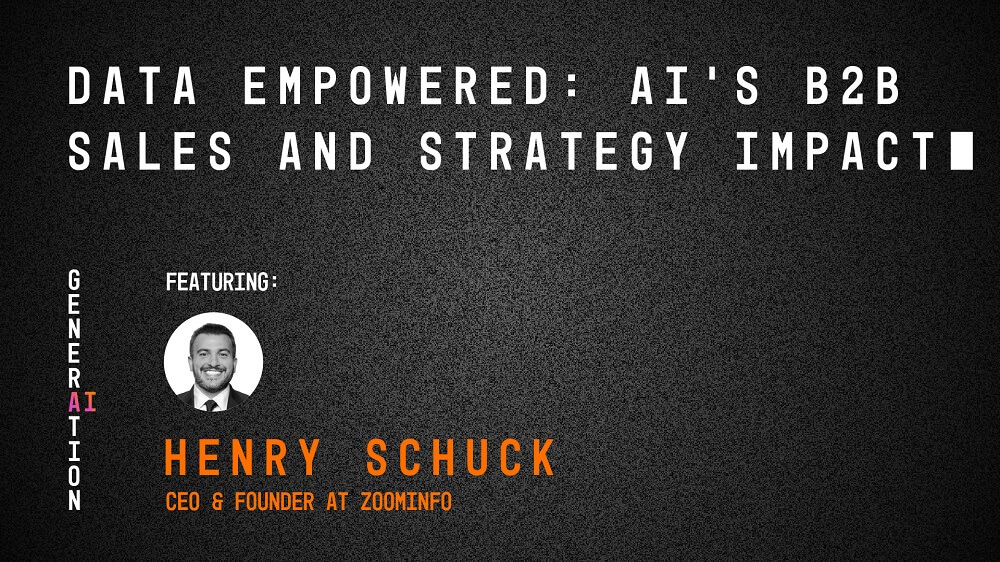PODCAST OVERVIEW
Data empowered: Generative AI models’ B2B sales and strategy impact
Learn how a generative model can bridge business gaps, based on our latest Generation AI podcast
August 30, 2023 • 6 minutes

The heart of any successful business is good data. But in an ever-more competitive digital environment currently exploding with innovation, data has to be more than just “good.”
Fortunately, artificial intelligence (AI) is just the right tool to gather, sort, analyze and deliver the right data your organization needs, at the right time, within the right context. We spoke with Henry Schuck, CEO and Founder at ZoomInfo about the evolution of data’s impact on business, the systems used to leverage it, and the critical role AI is already beginning to play in keeping the upper hand against the competition.
Shifting toward a more capable AI to deliver customer-centered business outcomes
Henry founded ZoomInfo with one driving purpose: to provide deep insights and contact information on decision-makers to sales and marketing professionals. With a goal to create organically pristine databases of customers, potential customers, and everything organizations need to know about them that’s easily accessible in the field, ZoomInfo set out to modernize go-to-market for all.
At the foundation of truly impactful information to drive B2B sales and marketing is data — something we have copious amounts of in the digital world. But getting the right data at the right time within a specific context can be challenging.
Leveraging AI is a promising way to gather, analyze, and enhance data to have the best impact on your overall business and go-to-market strategy.
When Henry first started his business, he immediately recognized the importance of using AI to drive business. Unfortunately, very smart, complex machine learning models were being designed to drive something, but that something tended to lack connectivity to the customer outcome.
With the guidance and focus on business outcomes and customer-centricity, the team was refocused on building generative AI models to gather input data and information from thousands of sources, all clearly driving towards explicit business objectives.
“We had these sources of data we were gathering, and with the new model, we were getting significantly more out of those sources,” Henry says. “Because we were able to plug AI models into what was once a rules-based engine, we were really able to drive outcomes for the business.”
Bridging the gap left by outdated software and ineffective CRMs with generative AI tools
According to Henry, there likely won’t be a day when companies don’t need CRMs. However, outdated software and ineffective CRMs will need additional support to remain relevant and useful for companies across industries.
With large language models and generative AI tools quickly becoming commoditized, focusing on the real opportunity of AI as a function of data richness and data quality will separate those who succeed from the rest.
“The data inside of your CRM is inaccurate — it’s wrong,” Henry says. “You have no infrastructural element that’s going to clean the data in those systems.”
As humans, we can agree that nothing looks the same on January 1st as it does on December 31st — people are changing jobs and getting promoted, meaning contact information necessary to streamline sales is simply not available as those changes take place. The companies you are trying to sell to and connect with will look completely different compared to today.
“To do nothing about those changes from a systems-driven way is negligence,” Henry says. “When you account for those changes, even 10% can make a huge impact on your downstream.”
Today, CRMs are central to how every business operates. It will continue to play a meaningful role in how any enterprise goes to market, organizes its customers, and thinks about opportunities. But to remain relevant, CRMs will need a few changes, particularly when generative modeling plays a larger role.
“To stay relevant for the masses, CRMs have to be capable of driving insights first, for salespeople, for marketing people,” Henry says. “And it has to be able to leverage really high-quality data to deliver those insights.”
The transformative impact a generative model can make in customer outreach, sales, and beyond
When it comes to using AI in business, there are a few key areas most focus on, and for good reason:
- Customer outreach
- Prospecting
- Customer engagement
Where CRMs are falling short, generative models are bridging the gap by providing up-to-date information. To achieve truly impactful customer outreach, sacrificing the knowledge regarding up-to-date information on companies and individuals is not an option. Sales and marketing teams must be equipped with the best knowledge possible.
Fortunately, companies like ZoomInfo are creating and offering generative AI options, taught and powered by humans, to fill in the gaps left by CRMs and ultimately give sales and marketing teams the best foundation possible.
Strategically implementing AI to retain data integrity and transform (not threaten) jobs
You can’t use untrained generative AI models — at least not if you want to ensure accuracy and ethics. According to Henry, there will always need to be humans in the loop.
For humans, this is great news. AI won’t be swooping in to threaten jobs. However, many jobs and roles will need to transform to meet the new demands of the modern digital environment.
“If you have humans who can define a data set and establish what’s right or wrong to really feed those models, you have a meaningful advantage,” Henry says. “You need to train that data set, and then the models get smarter and smarter over time.”
With a differentiator of human-checked information, ZoomInfo has retained researchers in its strategy. However, the specific jobs of those researchers have shifted — they are no longer cleansing and gathering data. Now, the research team is focused on tagging, identifying, and finding anomalies in the AI-delivered data. Additionally, humans are needed to do the work that generative models aren’t quite capable of figuring out.
Further, there will always be a need for a human touch, particularly when it comes to sales.
“It’s really hard to imagine a universe where somebody’s going to regularly spend six figures without interacting with a counterpart who can help them understand anomalies or decision-making criteria, who they can have trust with, who they feel is going to show up and help them when they’re implementing and deploying software, who’s their advocate inside of a company, and who helps them grow and innovate,” says Henry.
Rather than replacing sales professionals, AI will aid them with the virtual assistance necessary to optimize their impact and efficiency, according to Henry. This is where the role of a virtual SDR will likely come into play.
This virtual assistant will provide information such as:
- What efforts were made previously
- Who you should follow up with
- New opportunities to pursue
- Points of contact for those opportunities
- Which accounts are under-penetrated and require multi-threading
“This AI assistant will be your right hand or co-pilot,” Henry says. “It will go around with you and manage a bunch of your daily tasks, allowing you to be more focused on building relationships and building customer trust as a salesperson.”

